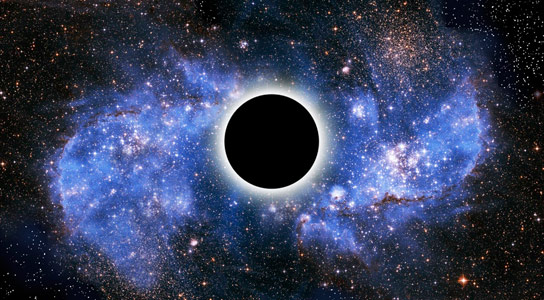The universe was created 13.7 billion years ago by an explosion, which begs the question: what caused it?
Three researchers at the Perimeter Institute have come up with a new theory about what might have happened before the big bang. It’s a little confusing, but it’s based on good math, can be tested, and is interesting enough to be on the cover of Scientific American with the title “The Black Hole at the Beginning of Time.” They say that what we think of as the “big bang” could be the “mirage” of a collapsing star in a universe that is very different from ours.

“Cosmology’s greatest challenge is understanding the big bang itself,” write Perimeter Institute Associate Faculty member Niayesh Afshordi, Affiliate Faculty member and University of Waterloo professor Robert Mann, and PhD student Razieh Pourhasan.
Most people think that the big bang started with a singularity, which is a point in spacetime that is so hot and dense that the normal laws of physics break down. Singularities are strange, and we don’t know much about them.
“For all physicists know, dragons could have come flying out of the singularity,” Afshordi says in an interview with Nature.
The problem, as far as the authors are concerned, is that the big bang theory says that our relatively easy-to-understand, uniform, and predictable universe came from a singularity that destroyed physics. It seems unlikely. So perhaps something else happened. Maybe our universe has always been made up of more than one thing.
Their idea is that the event horizon of a black hole could be the three-dimensional “wrapping” around a four-dimensional black hole. In this theory, our universe came into being when a star in a four-dimensional universe fell into a black hole.

In our three-dimensional universe, black holes have two-dimensional event horizons. This means that they are surrounded by a two-dimensional boundary that marks the “point of no return.” In a universe with four dimensions, a black hole would have an event horizon that is three-dimensional.
In their idea, our universe was never inside the singularity. Instead, it was created outside an event horizon, which kept it safe from the singularity. It started out as one part of a four-dimensional star that exploded, and it still is.
The researchers say that even though this idea may sound “strange,” it is based on the best math we have today for describing space and time. In particular, they have used holography tools to “make the big bang look like a cosmic mirage.” Along the way, their model seems to answer questions that have been around for a long time and, most importantly, makes predictions that can be tested.
The idea that everything and everyone we know came from the event horizon of a single four-dimensional black hole goes against our natural instincts. We have no idea what a universe with four dimensions might look like. We don’t know how a “parent” universe with four dimensions came to be.

But, the researchers say, our fallible intuitions evolved in a three-dimensional world that may only show us shadows of reality.
They compare it to Plato’s allegory of the cave, in which prisoners only see the flickering shadows of a fire on the wall of a cave for their whole lives.
“Their shackles have prevented them from perceiving the true world, a realm with one additional dimension,” they write. “Plato’s prisoners didn’t understand the powers behind the sun, just as we don’t understand the four-dimensional bulk universe. But at least they knew where to look for answers.”
Source: https://theancientzen.com







